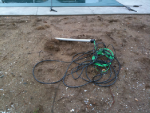- Aug 13, 2010
- 74
The ground has unfrozen, and it's time to finish the electrical hookup for my pool. I spent the winter reading NEC 680, so I'm an expert on this now and nothing can possibly go wrong...
The builder ran 1 1/4" PVC conduit from the pool light shell. The end of the conduit is now sticking out of the earth backfill, tightly taped closed with the wiring running out to a coil on the ground. I had planned to re-bury the conduit 18" deep and attach more conduit to extend it to a junction box on a post. Trouble is, the wiring shouldn't have been installed until the conduit run was completed, to prevent getting PVC solvent on the insulation.
Is there a usual way to finish the conduit run? My default approach is to just be really careful with the PVC solvent.
Thanks,
Sim
The builder ran 1 1/4" PVC conduit from the pool light shell. The end of the conduit is now sticking out of the earth backfill, tightly taped closed with the wiring running out to a coil on the ground. I had planned to re-bury the conduit 18" deep and attach more conduit to extend it to a junction box on a post. Trouble is, the wiring shouldn't have been installed until the conduit run was completed, to prevent getting PVC solvent on the insulation.
Is there a usual way to finish the conduit run? My default approach is to just be really careful with the PVC solvent.
Thanks,
Sim


